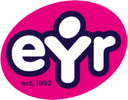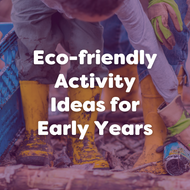Eco-friendly Activity Ideas for Early Years
Posted by EYR Team on 18th Dec 2023
read more
Fostering eco-friendly practices in the classroom is essential to instil a sense of responsibility and care for the environment from a young age. But what does eco-friendly mean? Being eco-friendly means making choices that are kind to our planet. It involves doing things in a way that doesn't harm the environment, like using less energy, reducing waste, and protecting nature. By being eco-friendly, we can help keep the Earth healthy and beautiful for ourselves and future generations. Read on to discover eco-friendly activity ideas for early years that are both engaging and fun.
1. Recycled art projects
Using recycled objects to make new art is a great way to teach children about recycling, and it's budget friendly! Try using things such as empty milk cartons, water bottles, and cardboard boxes to create imaginative and eco-friendly masterpieces. Not only does this hands-on approach ignite children's creativity, but it also imparts a valuable lesson about re-purposing and reducing waste.
Try making your very own Elmer the Patchwork Elephant with our handy guide!
2. Go on a scavenger hunt
Head outdoors and see what you can find! Use one of our free scavenger hunt downloads and race to see who can locate all the items first.
Scavenger hunts provide a dynamic and engaging platform for young children in their early years to cultivate a diverse array of essential skills that are crucial for their holistic development. Beyond the excitement of searching for hidden treasures, these activities offer a rich learning experience that encompasses personal, social, emotional, communication, and language skills.
3. Try gardening
Gardening is an ideal activity for early years children, and offers many benefits to childhood development and the curriculum.
As well as its hands-on and sensory nature, gardening encourages skills such as fine motor coordination, patience, and responsibility. It seamlessly integrates with a variety of subjects, promoting science exploration through plant growth observations, fostering environmental awareness, and enabling mathematical learning through measuring and counting tasks.
As children sow seeds and tend to plants, they develop a deeper connection with nature and gain valuable life skills. Simple activity ideas include planting seeds, identifying different plants, creating a mini-garden, and writing about their gardening experiences.
For more tips on how to create a garden, even in the smallest spaces, check out our blog on our very own urban garden.
4. Go litter picking
Litter picking encourages children to look after the environment around them, and helps them learn about recycling and the effect that litter has on nature.
Before you start litter picking, ensure that children know which items they can pick up and which are potentially dangerous. Avoid hazardous objects such as broken glass, clinical waste, or unidentified cans and chemical containers. Also make sure that protective gloves are worn at all times, and hands are washed thoroughly before eating, drinking, or going to the toilet.
To get started, use a litter picker and some gloves. You will also need bags to put the litter in, as well as hand sanitiser to avoid illness from poor hygiene.
5. Create art with nature
Nature offers a huge variety of creative art activities for children. Use leaves, sticks, wooden slices, pinecones, or anything you can get your hands on to create something beautiful on a budget! Some crafts you can do include:
- Leaf printing
- Paint rocks
- Press flowers onto fabric or paper
- Create a nature portrait
- Yarn wrapped sticks
6. Make your own recycled paper
Making your own recycled paper with children is a fun, creative and easy eco-friendly activity you can do in any setting. Here's how you make it:
- Rip paper into 2-inch pieces and put them in a blender
- Add enough water to cover the paper, and blend until the paper is a pulp
- Place a screen over a container, and pour the pulp onto it
- Use your hands to spread the pulp out evenly and press it with a towel to absorb the moisture
- Flip the paper onto a towel, remove the screen, and leave it to dry for about a day
- And you have paper! Use it for cards, drawing, collage and loads more!
We would love to see how you get on with your very own eco-friendly activities! Send us pictures of your masterpieces on Facebook or Instagram by tagging us or using the hashtag #ExploreWithEYR








